MGT300 Assignment: Analyzing HCL's Organizational Change Management
VerifiedAdded on 2022/12/29
|13
|2867
|1
Case Study
AI Summary
This case study report examines the organizational change management strategies implemented at HCL Technologies, focusing on the leadership of Vineet Nayar. It analyzes the company's transformation in response to the evolving IT services industry, emphasizing the 'employee first' philosophy. The report details the drivers of change, including both internal and external forces, and evaluates the effectiveness of HCL's reactive and proactive approaches. It also discusses the situational and historical factors that prompted the changes, the objectives of the change intervention, and the emotional responses of employees. Furthermore, the report outlines the steps of execution, including the implementation of transparency initiatives and employee engagement strategies, and concludes with recommendations based on the analysis. The analysis highlights how HCL addressed challenges as opportunities for growth and developed collaborative strategies to meet market needs, ultimately leading to significant revenue increases and recognition as a top employer.
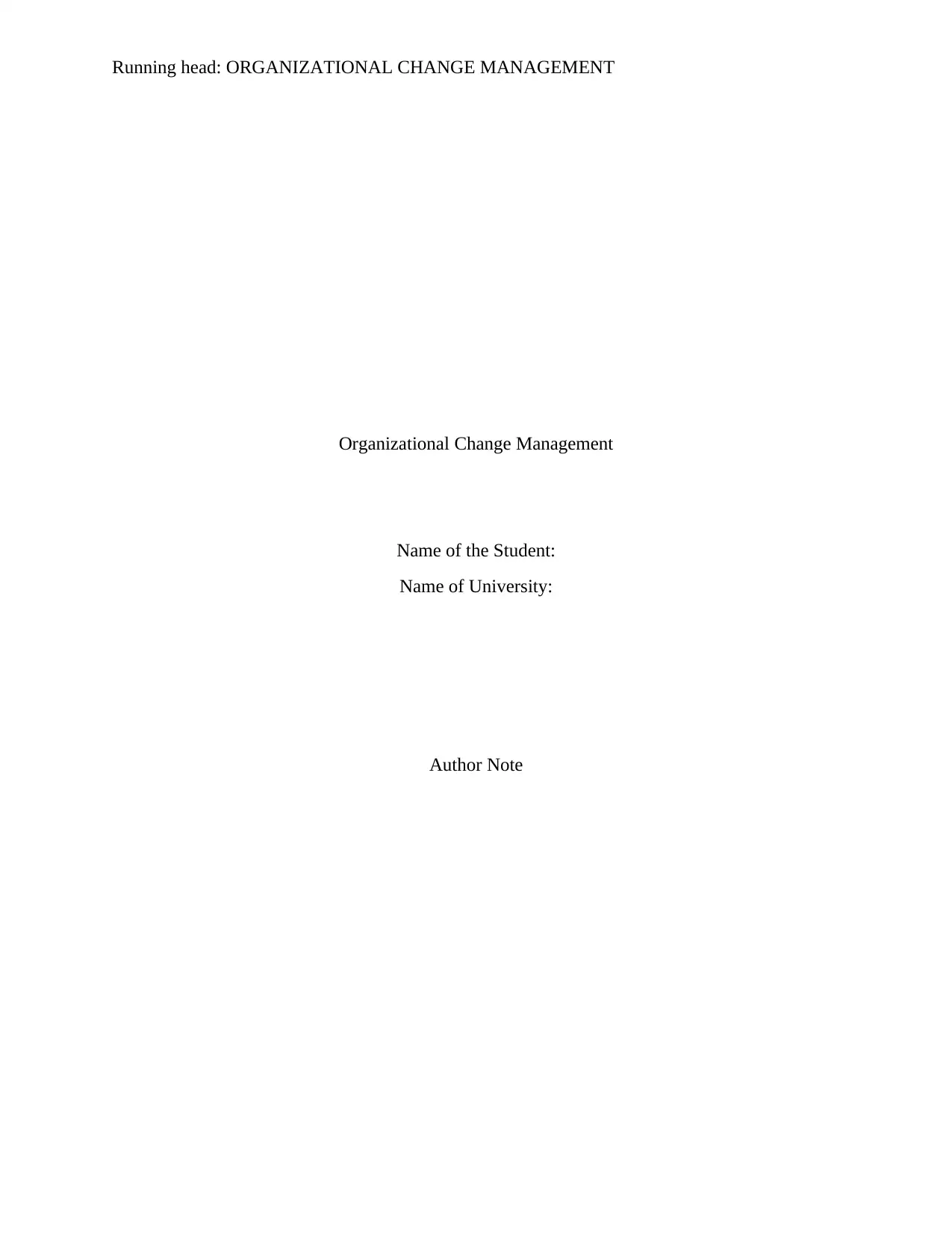
Running head: ORGANIZATIONAL CHANGE MANAGEMENT
Organizational Change Management
Name of the Student:
Name of University:
Author Note
Organizational Change Management
Name of the Student:
Name of University:
Author Note
Paraphrase This Document
Need a fresh take? Get an instant paraphrase of this document with our AI Paraphraser
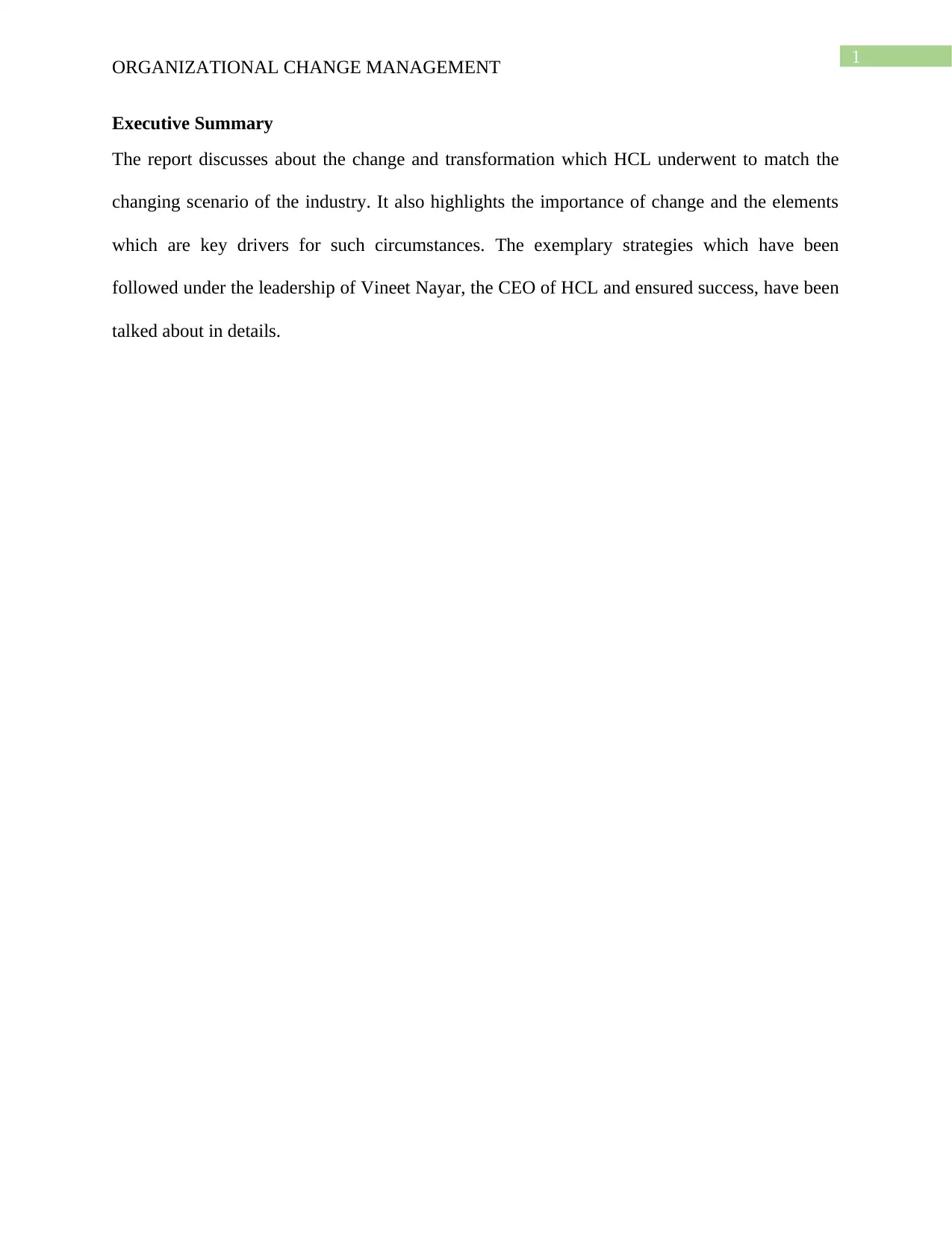
1
ORGANIZATIONAL CHANGE MANAGEMENT
Executive Summary
The report discusses about the change and transformation which HCL underwent to match the
changing scenario of the industry. It also highlights the importance of change and the elements
which are key drivers for such circumstances. The exemplary strategies which have been
followed under the leadership of Vineet Nayar, the CEO of HCL and ensured success, have been
talked about in details.
ORGANIZATIONAL CHANGE MANAGEMENT
Executive Summary
The report discusses about the change and transformation which HCL underwent to match the
changing scenario of the industry. It also highlights the importance of change and the elements
which are key drivers for such circumstances. The exemplary strategies which have been
followed under the leadership of Vineet Nayar, the CEO of HCL and ensured success, have been
talked about in details.
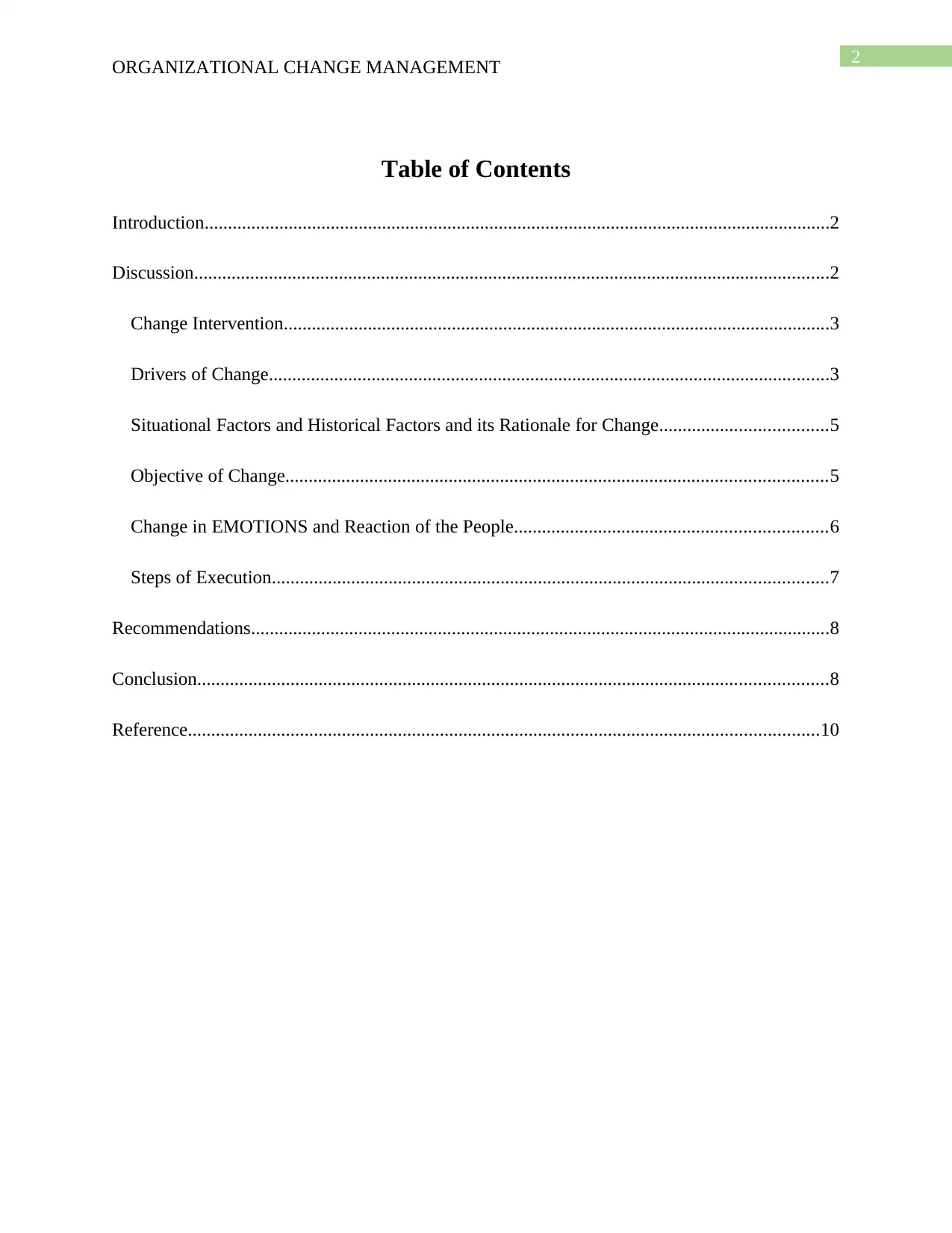
2
ORGANIZATIONAL CHANGE MANAGEMENT
Table of Contents
Introduction......................................................................................................................................2
Discussion........................................................................................................................................2
Change Intervention.....................................................................................................................3
Drivers of Change........................................................................................................................3
Situational Factors and Historical Factors and its Rationale for Change....................................5
Objective of Change....................................................................................................................5
Change in EMOTIONS and Reaction of the People...................................................................6
Steps of Execution.......................................................................................................................7
Recommendations............................................................................................................................8
Conclusion.......................................................................................................................................8
Reference.......................................................................................................................................10
ORGANIZATIONAL CHANGE MANAGEMENT
Table of Contents
Introduction......................................................................................................................................2
Discussion........................................................................................................................................2
Change Intervention.....................................................................................................................3
Drivers of Change........................................................................................................................3
Situational Factors and Historical Factors and its Rationale for Change....................................5
Objective of Change....................................................................................................................5
Change in EMOTIONS and Reaction of the People...................................................................6
Steps of Execution.......................................................................................................................7
Recommendations............................................................................................................................8
Conclusion.......................................................................................................................................8
Reference.......................................................................................................................................10
⊘ This is a preview!⊘
Do you want full access?
Subscribe today to unlock all pages.

Trusted by 1+ million students worldwide
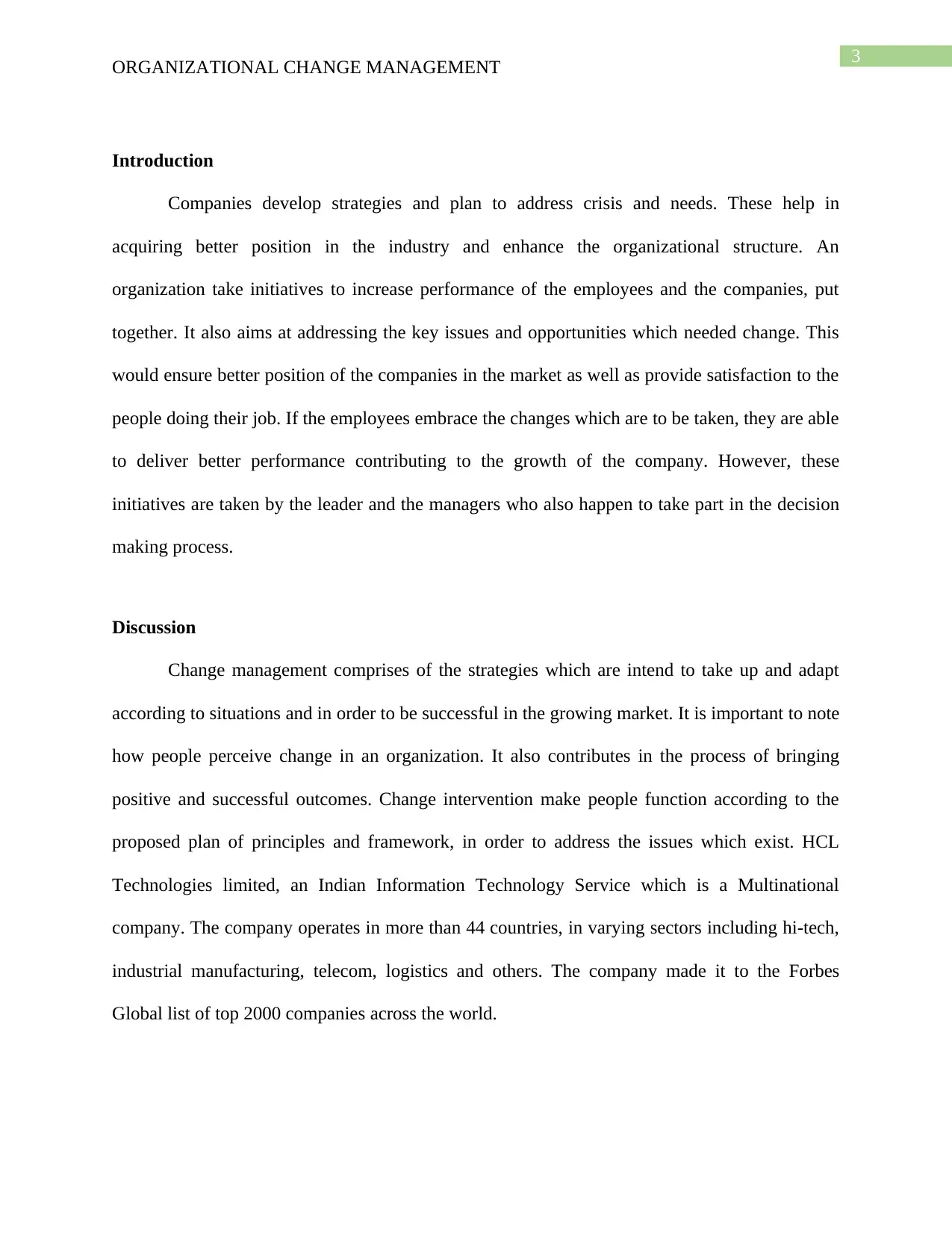
3
ORGANIZATIONAL CHANGE MANAGEMENT
Introduction
Companies develop strategies and plan to address crisis and needs. These help in
acquiring better position in the industry and enhance the organizational structure. An
organization take initiatives to increase performance of the employees and the companies, put
together. It also aims at addressing the key issues and opportunities which needed change. This
would ensure better position of the companies in the market as well as provide satisfaction to the
people doing their job. If the employees embrace the changes which are to be taken, they are able
to deliver better performance contributing to the growth of the company. However, these
initiatives are taken by the leader and the managers who also happen to take part in the decision
making process.
Discussion
Change management comprises of the strategies which are intend to take up and adapt
according to situations and in order to be successful in the growing market. It is important to note
how people perceive change in an organization. It also contributes in the process of bringing
positive and successful outcomes. Change intervention make people function according to the
proposed plan of principles and framework, in order to address the issues which exist. HCL
Technologies limited, an Indian Information Technology Service which is a Multinational
company. The company operates in more than 44 countries, in varying sectors including hi-tech,
industrial manufacturing, telecom, logistics and others. The company made it to the Forbes
Global list of top 2000 companies across the world.
ORGANIZATIONAL CHANGE MANAGEMENT
Introduction
Companies develop strategies and plan to address crisis and needs. These help in
acquiring better position in the industry and enhance the organizational structure. An
organization take initiatives to increase performance of the employees and the companies, put
together. It also aims at addressing the key issues and opportunities which needed change. This
would ensure better position of the companies in the market as well as provide satisfaction to the
people doing their job. If the employees embrace the changes which are to be taken, they are able
to deliver better performance contributing to the growth of the company. However, these
initiatives are taken by the leader and the managers who also happen to take part in the decision
making process.
Discussion
Change management comprises of the strategies which are intend to take up and adapt
according to situations and in order to be successful in the growing market. It is important to note
how people perceive change in an organization. It also contributes in the process of bringing
positive and successful outcomes. Change intervention make people function according to the
proposed plan of principles and framework, in order to address the issues which exist. HCL
Technologies limited, an Indian Information Technology Service which is a Multinational
company. The company operates in more than 44 countries, in varying sectors including hi-tech,
industrial manufacturing, telecom, logistics and others. The company made it to the Forbes
Global list of top 2000 companies across the world.
Paraphrase This Document
Need a fresh take? Get an instant paraphrase of this document with our AI Paraphraser
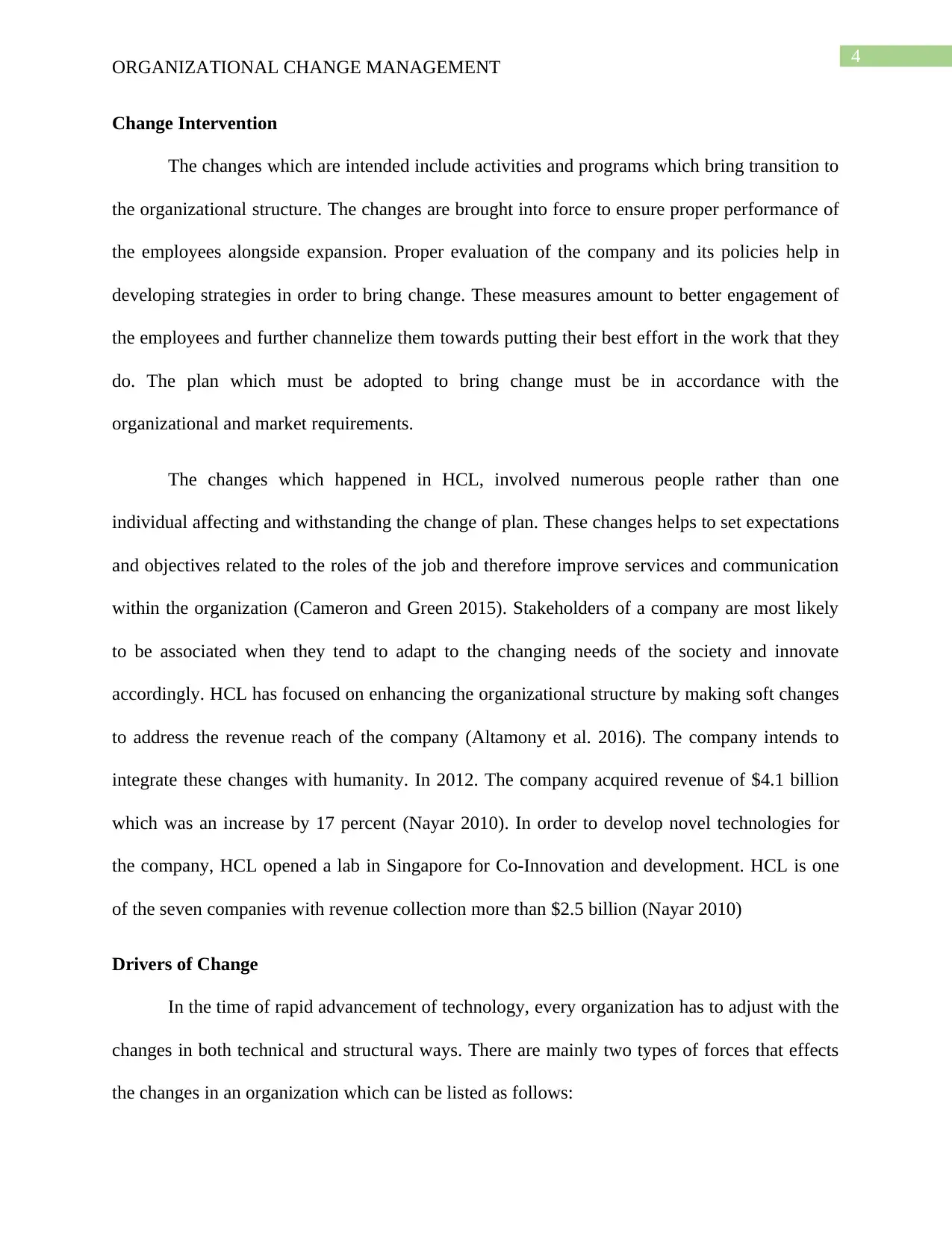
4
ORGANIZATIONAL CHANGE MANAGEMENT
Change Intervention
The changes which are intended include activities and programs which bring transition to
the organizational structure. The changes are brought into force to ensure proper performance of
the employees alongside expansion. Proper evaluation of the company and its policies help in
developing strategies in order to bring change. These measures amount to better engagement of
the employees and further channelize them towards putting their best effort in the work that they
do. The plan which must be adopted to bring change must be in accordance with the
organizational and market requirements.
The changes which happened in HCL, involved numerous people rather than one
individual affecting and withstanding the change of plan. These changes helps to set expectations
and objectives related to the roles of the job and therefore improve services and communication
within the organization (Cameron and Green 2015). Stakeholders of a company are most likely
to be associated when they tend to adapt to the changing needs of the society and innovate
accordingly. HCL has focused on enhancing the organizational structure by making soft changes
to address the revenue reach of the company (Altamony et al. 2016). The company intends to
integrate these changes with humanity. In 2012. The company acquired revenue of $4.1 billion
which was an increase by 17 percent (Nayar 2010). In order to develop novel technologies for
the company, HCL opened a lab in Singapore for Co-Innovation and development. HCL is one
of the seven companies with revenue collection more than $2.5 billion (Nayar 2010)
Drivers of Change
In the time of rapid advancement of technology, every organization has to adjust with the
changes in both technical and structural ways. There are mainly two types of forces that effects
the changes in an organization which can be listed as follows:
ORGANIZATIONAL CHANGE MANAGEMENT
Change Intervention
The changes which are intended include activities and programs which bring transition to
the organizational structure. The changes are brought into force to ensure proper performance of
the employees alongside expansion. Proper evaluation of the company and its policies help in
developing strategies in order to bring change. These measures amount to better engagement of
the employees and further channelize them towards putting their best effort in the work that they
do. The plan which must be adopted to bring change must be in accordance with the
organizational and market requirements.
The changes which happened in HCL, involved numerous people rather than one
individual affecting and withstanding the change of plan. These changes helps to set expectations
and objectives related to the roles of the job and therefore improve services and communication
within the organization (Cameron and Green 2015). Stakeholders of a company are most likely
to be associated when they tend to adapt to the changing needs of the society and innovate
accordingly. HCL has focused on enhancing the organizational structure by making soft changes
to address the revenue reach of the company (Altamony et al. 2016). The company intends to
integrate these changes with humanity. In 2012. The company acquired revenue of $4.1 billion
which was an increase by 17 percent (Nayar 2010). In order to develop novel technologies for
the company, HCL opened a lab in Singapore for Co-Innovation and development. HCL is one
of the seven companies with revenue collection more than $2.5 billion (Nayar 2010)
Drivers of Change
In the time of rapid advancement of technology, every organization has to adjust with the
changes in both technical and structural ways. There are mainly two types of forces that effects
the changes in an organization which can be listed as follows:
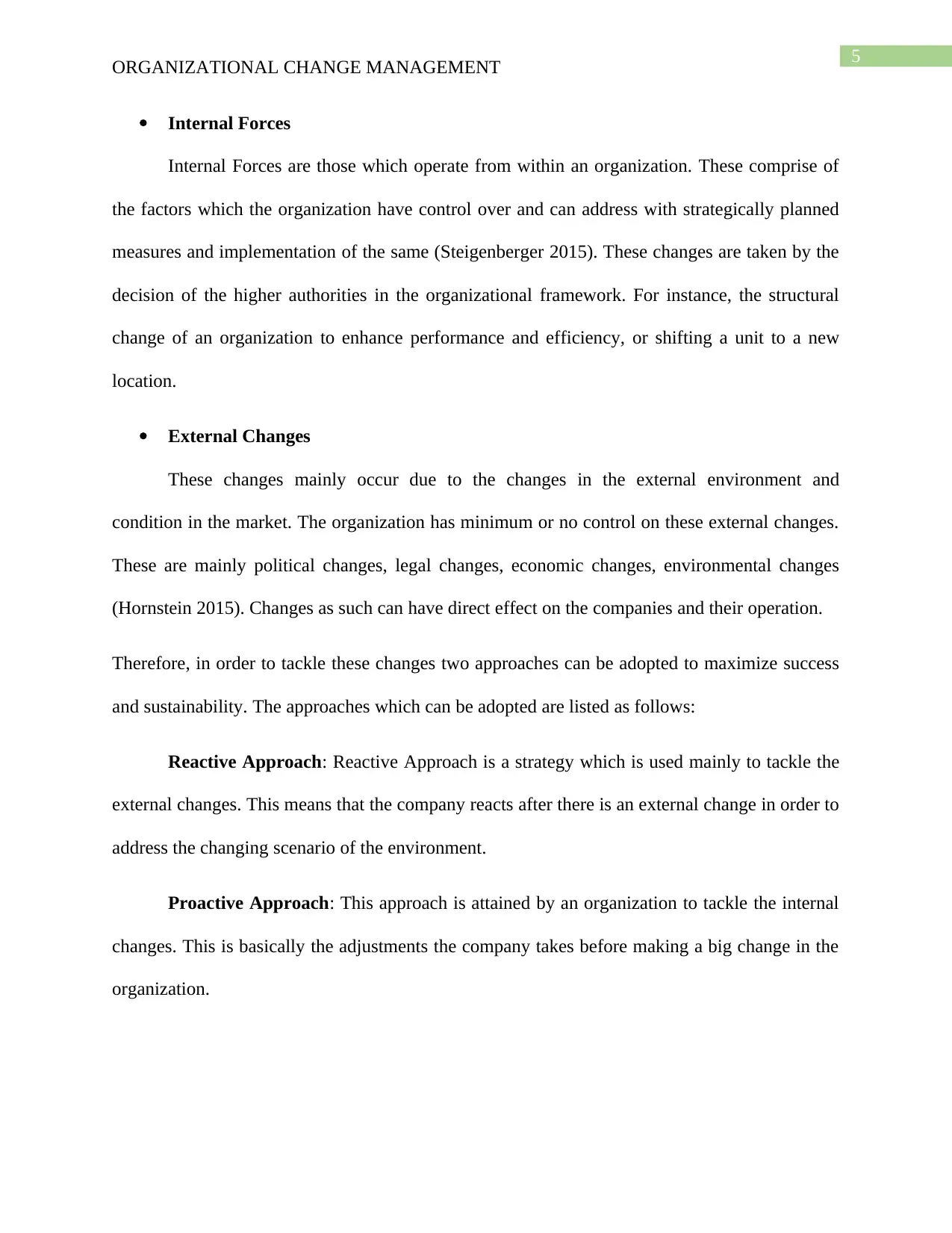
5
ORGANIZATIONAL CHANGE MANAGEMENT
Internal Forces
Internal Forces are those which operate from within an organization. These comprise of
the factors which the organization have control over and can address with strategically planned
measures and implementation of the same (Steigenberger 2015). These changes are taken by the
decision of the higher authorities in the organizational framework. For instance, the structural
change of an organization to enhance performance and efficiency, or shifting a unit to a new
location.
External Changes
These changes mainly occur due to the changes in the external environment and
condition in the market. The organization has minimum or no control on these external changes.
These are mainly political changes, legal changes, economic changes, environmental changes
(Hornstein 2015). Changes as such can have direct effect on the companies and their operation.
Therefore, in order to tackle these changes two approaches can be adopted to maximize success
and sustainability. The approaches which can be adopted are listed as follows:
Reactive Approach: Reactive Approach is a strategy which is used mainly to tackle the
external changes. This means that the company reacts after there is an external change in order to
address the changing scenario of the environment.
Proactive Approach: This approach is attained by an organization to tackle the internal
changes. This is basically the adjustments the company takes before making a big change in the
organization.
ORGANIZATIONAL CHANGE MANAGEMENT
Internal Forces
Internal Forces are those which operate from within an organization. These comprise of
the factors which the organization have control over and can address with strategically planned
measures and implementation of the same (Steigenberger 2015). These changes are taken by the
decision of the higher authorities in the organizational framework. For instance, the structural
change of an organization to enhance performance and efficiency, or shifting a unit to a new
location.
External Changes
These changes mainly occur due to the changes in the external environment and
condition in the market. The organization has minimum or no control on these external changes.
These are mainly political changes, legal changes, economic changes, environmental changes
(Hornstein 2015). Changes as such can have direct effect on the companies and their operation.
Therefore, in order to tackle these changes two approaches can be adopted to maximize success
and sustainability. The approaches which can be adopted are listed as follows:
Reactive Approach: Reactive Approach is a strategy which is used mainly to tackle the
external changes. This means that the company reacts after there is an external change in order to
address the changing scenario of the environment.
Proactive Approach: This approach is attained by an organization to tackle the internal
changes. This is basically the adjustments the company takes before making a big change in the
organization.
⊘ This is a preview!⊘
Do you want full access?
Subscribe today to unlock all pages.

Trusted by 1+ million students worldwide
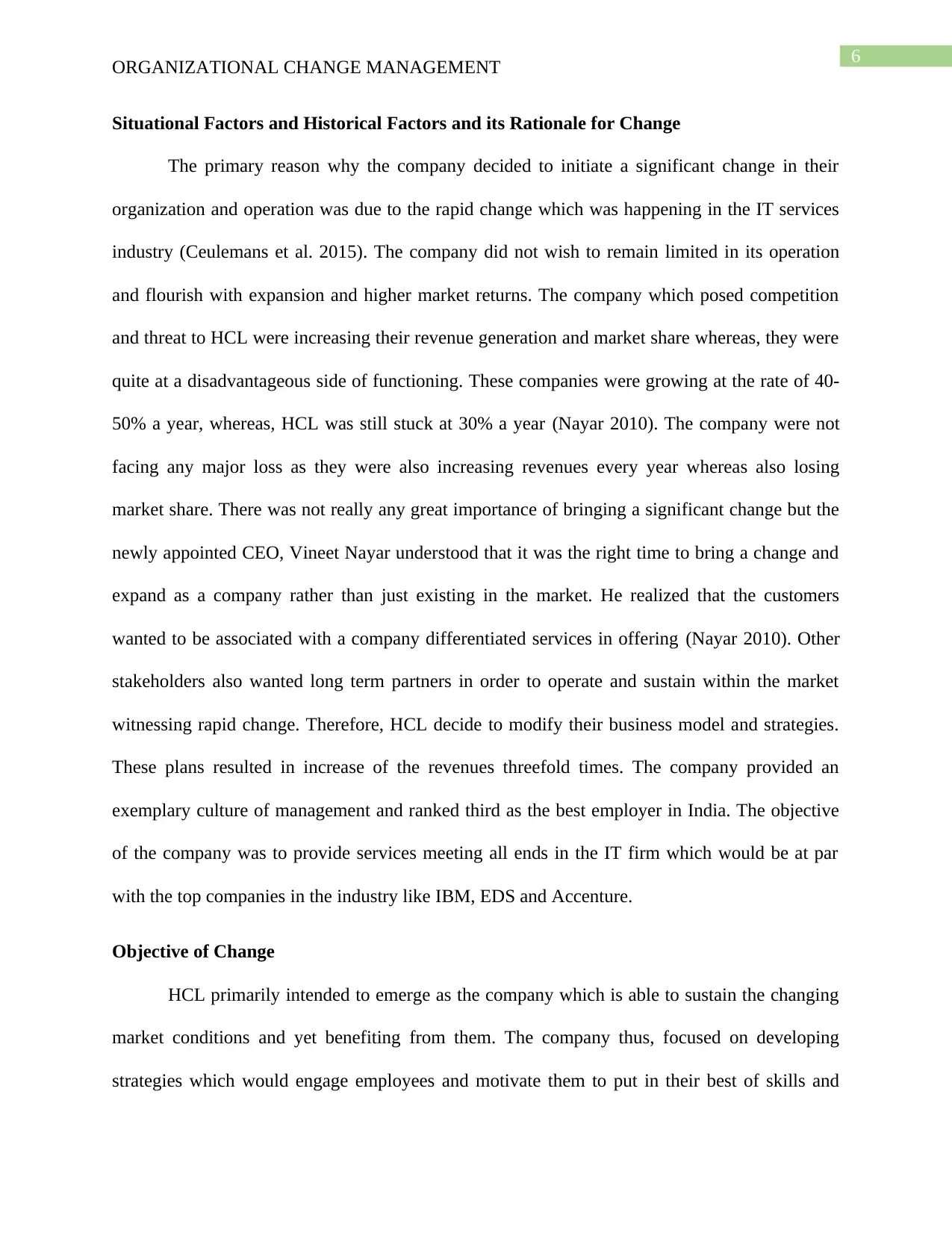
6
ORGANIZATIONAL CHANGE MANAGEMENT
Situational Factors and Historical Factors and its Rationale for Change
The primary reason why the company decided to initiate a significant change in their
organization and operation was due to the rapid change which was happening in the IT services
industry (Ceulemans et al. 2015). The company did not wish to remain limited in its operation
and flourish with expansion and higher market returns. The company which posed competition
and threat to HCL were increasing their revenue generation and market share whereas, they were
quite at a disadvantageous side of functioning. These companies were growing at the rate of 40-
50% a year, whereas, HCL was still stuck at 30% a year (Nayar 2010). The company were not
facing any major loss as they were also increasing revenues every year whereas also losing
market share. There was not really any great importance of bringing a significant change but the
newly appointed CEO, Vineet Nayar understood that it was the right time to bring a change and
expand as a company rather than just existing in the market. He realized that the customers
wanted to be associated with a company differentiated services in offering (Nayar 2010). Other
stakeholders also wanted long term partners in order to operate and sustain within the market
witnessing rapid change. Therefore, HCL decide to modify their business model and strategies.
These plans resulted in increase of the revenues threefold times. The company provided an
exemplary culture of management and ranked third as the best employer in India. The objective
of the company was to provide services meeting all ends in the IT firm which would be at par
with the top companies in the industry like IBM, EDS and Accenture.
Objective of Change
HCL primarily intended to emerge as the company which is able to sustain the changing
market conditions and yet benefiting from them. The company thus, focused on developing
strategies which would engage employees and motivate them to put in their best of skills and
ORGANIZATIONAL CHANGE MANAGEMENT
Situational Factors and Historical Factors and its Rationale for Change
The primary reason why the company decided to initiate a significant change in their
organization and operation was due to the rapid change which was happening in the IT services
industry (Ceulemans et al. 2015). The company did not wish to remain limited in its operation
and flourish with expansion and higher market returns. The company which posed competition
and threat to HCL were increasing their revenue generation and market share whereas, they were
quite at a disadvantageous side of functioning. These companies were growing at the rate of 40-
50% a year, whereas, HCL was still stuck at 30% a year (Nayar 2010). The company were not
facing any major loss as they were also increasing revenues every year whereas also losing
market share. There was not really any great importance of bringing a significant change but the
newly appointed CEO, Vineet Nayar understood that it was the right time to bring a change and
expand as a company rather than just existing in the market. He realized that the customers
wanted to be associated with a company differentiated services in offering (Nayar 2010). Other
stakeholders also wanted long term partners in order to operate and sustain within the market
witnessing rapid change. Therefore, HCL decide to modify their business model and strategies.
These plans resulted in increase of the revenues threefold times. The company provided an
exemplary culture of management and ranked third as the best employer in India. The objective
of the company was to provide services meeting all ends in the IT firm which would be at par
with the top companies in the industry like IBM, EDS and Accenture.
Objective of Change
HCL primarily intended to emerge as the company which is able to sustain the changing
market conditions and yet benefiting from them. The company thus, focused on developing
strategies which would engage employees and motivate them to put in their best of skills and
Paraphrase This Document
Need a fresh take? Get an instant paraphrase of this document with our AI Paraphraser
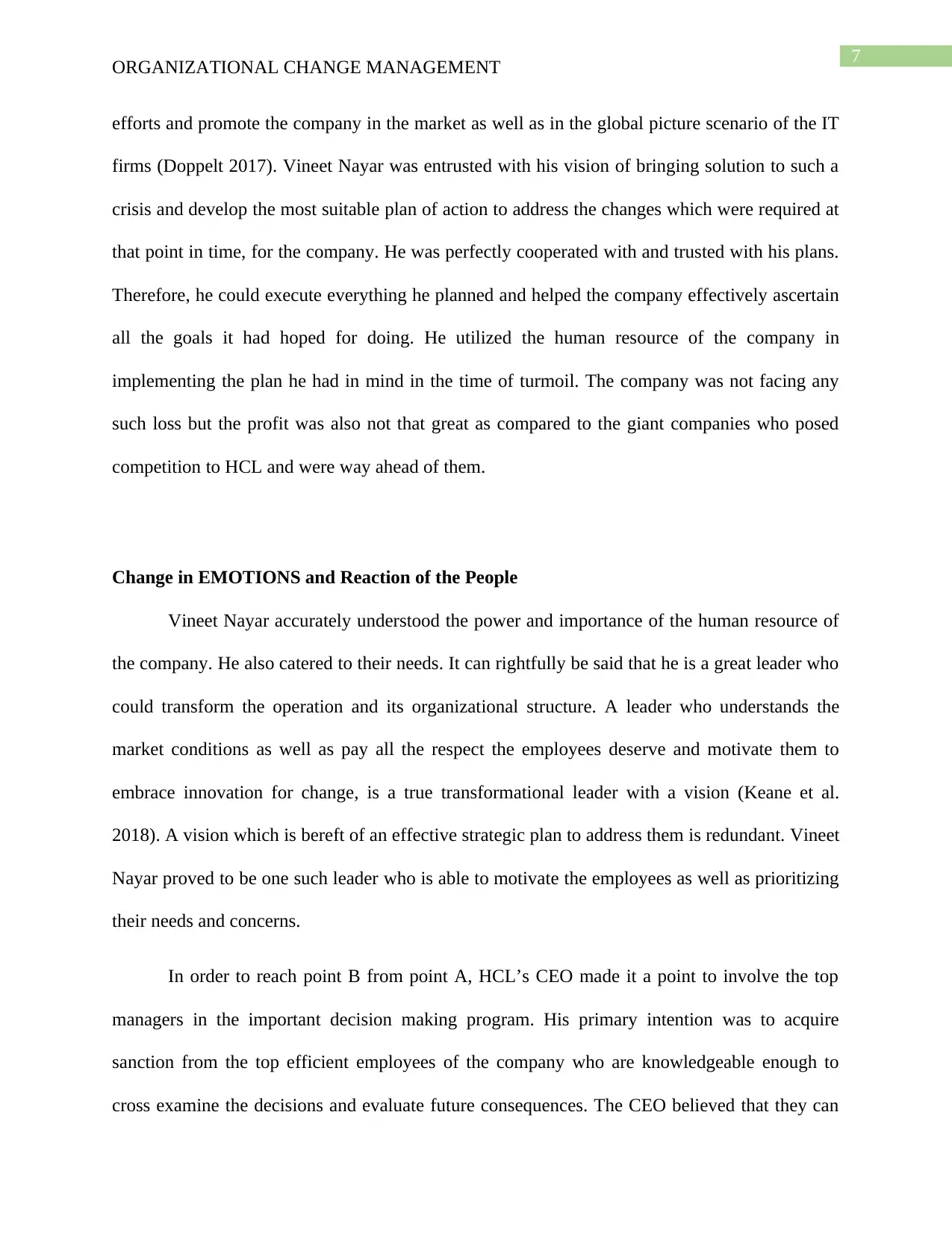
7
ORGANIZATIONAL CHANGE MANAGEMENT
efforts and promote the company in the market as well as in the global picture scenario of the IT
firms (Doppelt 2017). Vineet Nayar was entrusted with his vision of bringing solution to such a
crisis and develop the most suitable plan of action to address the changes which were required at
that point in time, for the company. He was perfectly cooperated with and trusted with his plans.
Therefore, he could execute everything he planned and helped the company effectively ascertain
all the goals it had hoped for doing. He utilized the human resource of the company in
implementing the plan he had in mind in the time of turmoil. The company was not facing any
such loss but the profit was also not that great as compared to the giant companies who posed
competition to HCL and were way ahead of them.
Change in EMOTIONS and Reaction of the People
Vineet Nayar accurately understood the power and importance of the human resource of
the company. He also catered to their needs. It can rightfully be said that he is a great leader who
could transform the operation and its organizational structure. A leader who understands the
market conditions as well as pay all the respect the employees deserve and motivate them to
embrace innovation for change, is a true transformational leader with a vision (Keane et al.
2018). A vision which is bereft of an effective strategic plan to address them is redundant. Vineet
Nayar proved to be one such leader who is able to motivate the employees as well as prioritizing
their needs and concerns.
In order to reach point B from point A, HCL’s CEO made it a point to involve the top
managers in the important decision making program. His primary intention was to acquire
sanction from the top efficient employees of the company who are knowledgeable enough to
cross examine the decisions and evaluate future consequences. The CEO believed that they can
ORGANIZATIONAL CHANGE MANAGEMENT
efforts and promote the company in the market as well as in the global picture scenario of the IT
firms (Doppelt 2017). Vineet Nayar was entrusted with his vision of bringing solution to such a
crisis and develop the most suitable plan of action to address the changes which were required at
that point in time, for the company. He was perfectly cooperated with and trusted with his plans.
Therefore, he could execute everything he planned and helped the company effectively ascertain
all the goals it had hoped for doing. He utilized the human resource of the company in
implementing the plan he had in mind in the time of turmoil. The company was not facing any
such loss but the profit was also not that great as compared to the giant companies who posed
competition to HCL and were way ahead of them.
Change in EMOTIONS and Reaction of the People
Vineet Nayar accurately understood the power and importance of the human resource of
the company. He also catered to their needs. It can rightfully be said that he is a great leader who
could transform the operation and its organizational structure. A leader who understands the
market conditions as well as pay all the respect the employees deserve and motivate them to
embrace innovation for change, is a true transformational leader with a vision (Keane et al.
2018). A vision which is bereft of an effective strategic plan to address them is redundant. Vineet
Nayar proved to be one such leader who is able to motivate the employees as well as prioritizing
their needs and concerns.
In order to reach point B from point A, HCL’s CEO made it a point to involve the top
managers in the important decision making program. His primary intention was to acquire
sanction from the top efficient employees of the company who are knowledgeable enough to
cross examine the decisions and evaluate future consequences. The CEO believed that they can
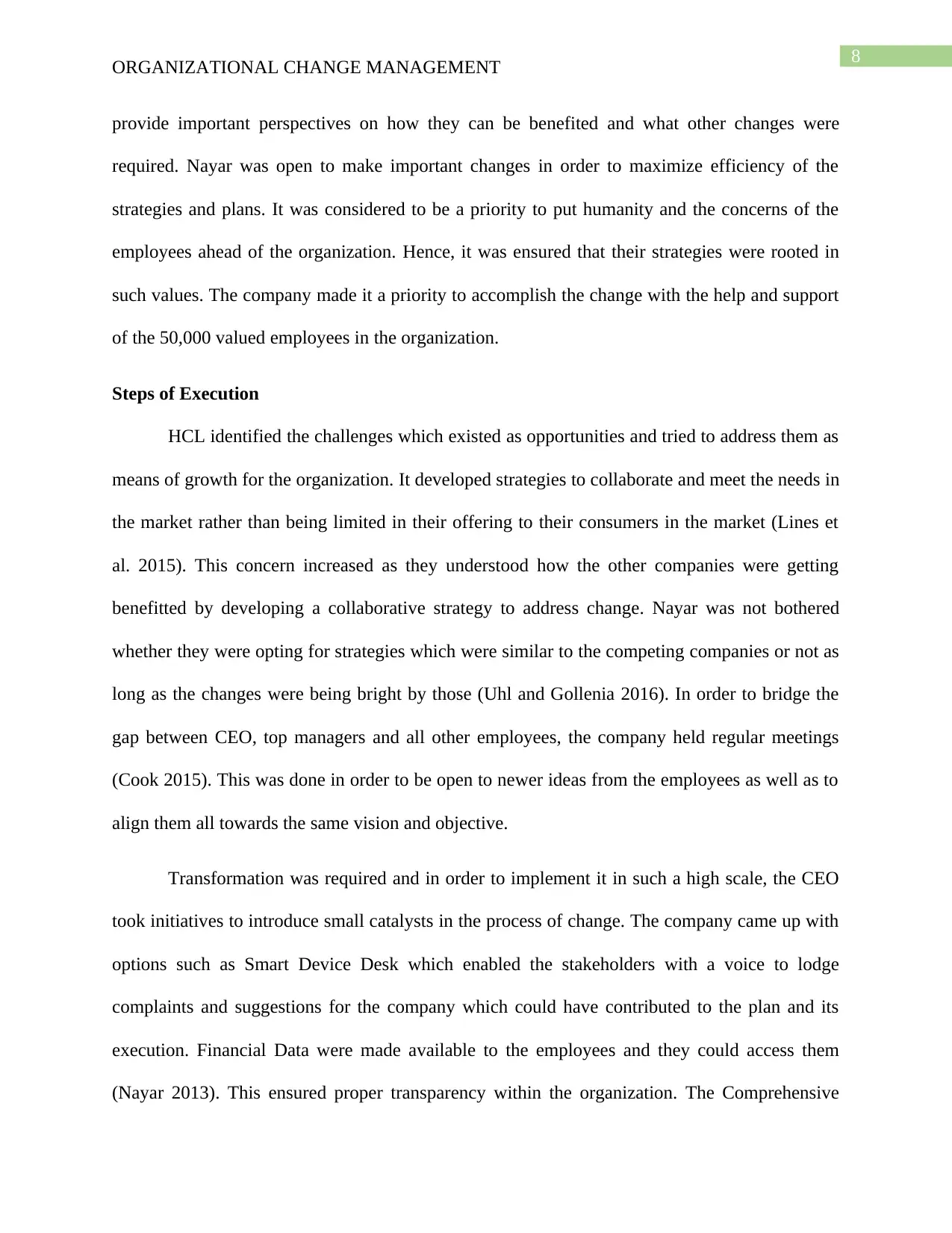
8
ORGANIZATIONAL CHANGE MANAGEMENT
provide important perspectives on how they can be benefited and what other changes were
required. Nayar was open to make important changes in order to maximize efficiency of the
strategies and plans. It was considered to be a priority to put humanity and the concerns of the
employees ahead of the organization. Hence, it was ensured that their strategies were rooted in
such values. The company made it a priority to accomplish the change with the help and support
of the 50,000 valued employees in the organization.
Steps of Execution
HCL identified the challenges which existed as opportunities and tried to address them as
means of growth for the organization. It developed strategies to collaborate and meet the needs in
the market rather than being limited in their offering to their consumers in the market (Lines et
al. 2015). This concern increased as they understood how the other companies were getting
benefitted by developing a collaborative strategy to address change. Nayar was not bothered
whether they were opting for strategies which were similar to the competing companies or not as
long as the changes were being bright by those (Uhl and Gollenia 2016). In order to bridge the
gap between CEO, top managers and all other employees, the company held regular meetings
(Cook 2015). This was done in order to be open to newer ideas from the employees as well as to
align them all towards the same vision and objective.
Transformation was required and in order to implement it in such a high scale, the CEO
took initiatives to introduce small catalysts in the process of change. The company came up with
options such as Smart Device Desk which enabled the stakeholders with a voice to lodge
complaints and suggestions for the company which could have contributed to the plan and its
execution. Financial Data were made available to the employees and they could access them
(Nayar 2013). This ensured proper transparency within the organization. The Comprehensive
ORGANIZATIONAL CHANGE MANAGEMENT
provide important perspectives on how they can be benefited and what other changes were
required. Nayar was open to make important changes in order to maximize efficiency of the
strategies and plans. It was considered to be a priority to put humanity and the concerns of the
employees ahead of the organization. Hence, it was ensured that their strategies were rooted in
such values. The company made it a priority to accomplish the change with the help and support
of the 50,000 valued employees in the organization.
Steps of Execution
HCL identified the challenges which existed as opportunities and tried to address them as
means of growth for the organization. It developed strategies to collaborate and meet the needs in
the market rather than being limited in their offering to their consumers in the market (Lines et
al. 2015). This concern increased as they understood how the other companies were getting
benefitted by developing a collaborative strategy to address change. Nayar was not bothered
whether they were opting for strategies which were similar to the competing companies or not as
long as the changes were being bright by those (Uhl and Gollenia 2016). In order to bridge the
gap between CEO, top managers and all other employees, the company held regular meetings
(Cook 2015). This was done in order to be open to newer ideas from the employees as well as to
align them all towards the same vision and objective.
Transformation was required and in order to implement it in such a high scale, the CEO
took initiatives to introduce small catalysts in the process of change. The company came up with
options such as Smart Device Desk which enabled the stakeholders with a voice to lodge
complaints and suggestions for the company which could have contributed to the plan and its
execution. Financial Data were made available to the employees and they could access them
(Nayar 2013). This ensured proper transparency within the organization. The Comprehensive
⊘ This is a preview!⊘
Do you want full access?
Subscribe today to unlock all pages.

Trusted by 1+ million students worldwide
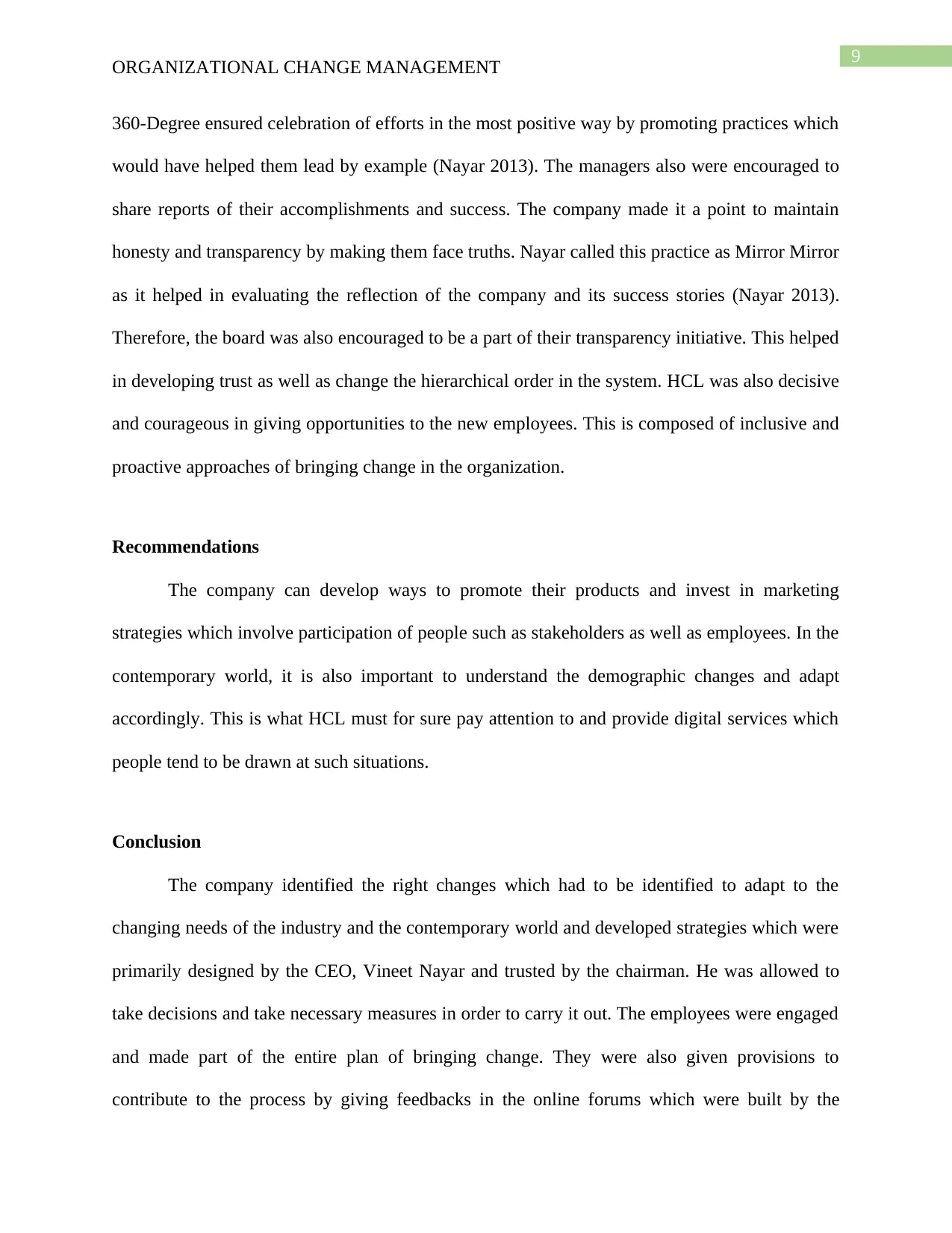
9
ORGANIZATIONAL CHANGE MANAGEMENT
360-Degree ensured celebration of efforts in the most positive way by promoting practices which
would have helped them lead by example (Nayar 2013). The managers also were encouraged to
share reports of their accomplishments and success. The company made it a point to maintain
honesty and transparency by making them face truths. Nayar called this practice as Mirror Mirror
as it helped in evaluating the reflection of the company and its success stories (Nayar 2013).
Therefore, the board was also encouraged to be a part of their transparency initiative. This helped
in developing trust as well as change the hierarchical order in the system. HCL was also decisive
and courageous in giving opportunities to the new employees. This is composed of inclusive and
proactive approaches of bringing change in the organization.
Recommendations
The company can develop ways to promote their products and invest in marketing
strategies which involve participation of people such as stakeholders as well as employees. In the
contemporary world, it is also important to understand the demographic changes and adapt
accordingly. This is what HCL must for sure pay attention to and provide digital services which
people tend to be drawn at such situations.
Conclusion
The company identified the right changes which had to be identified to adapt to the
changing needs of the industry and the contemporary world and developed strategies which were
primarily designed by the CEO, Vineet Nayar and trusted by the chairman. He was allowed to
take decisions and take necessary measures in order to carry it out. The employees were engaged
and made part of the entire plan of bringing change. They were also given provisions to
contribute to the process by giving feedbacks in the online forums which were built by the
ORGANIZATIONAL CHANGE MANAGEMENT
360-Degree ensured celebration of efforts in the most positive way by promoting practices which
would have helped them lead by example (Nayar 2013). The managers also were encouraged to
share reports of their accomplishments and success. The company made it a point to maintain
honesty and transparency by making them face truths. Nayar called this practice as Mirror Mirror
as it helped in evaluating the reflection of the company and its success stories (Nayar 2013).
Therefore, the board was also encouraged to be a part of their transparency initiative. This helped
in developing trust as well as change the hierarchical order in the system. HCL was also decisive
and courageous in giving opportunities to the new employees. This is composed of inclusive and
proactive approaches of bringing change in the organization.
Recommendations
The company can develop ways to promote their products and invest in marketing
strategies which involve participation of people such as stakeholders as well as employees. In the
contemporary world, it is also important to understand the demographic changes and adapt
accordingly. This is what HCL must for sure pay attention to and provide digital services which
people tend to be drawn at such situations.
Conclusion
The company identified the right changes which had to be identified to adapt to the
changing needs of the industry and the contemporary world and developed strategies which were
primarily designed by the CEO, Vineet Nayar and trusted by the chairman. He was allowed to
take decisions and take necessary measures in order to carry it out. The employees were engaged
and made part of the entire plan of bringing change. They were also given provisions to
contribute to the process by giving feedbacks in the online forums which were built by the
Paraphrase This Document
Need a fresh take? Get an instant paraphrase of this document with our AI Paraphraser
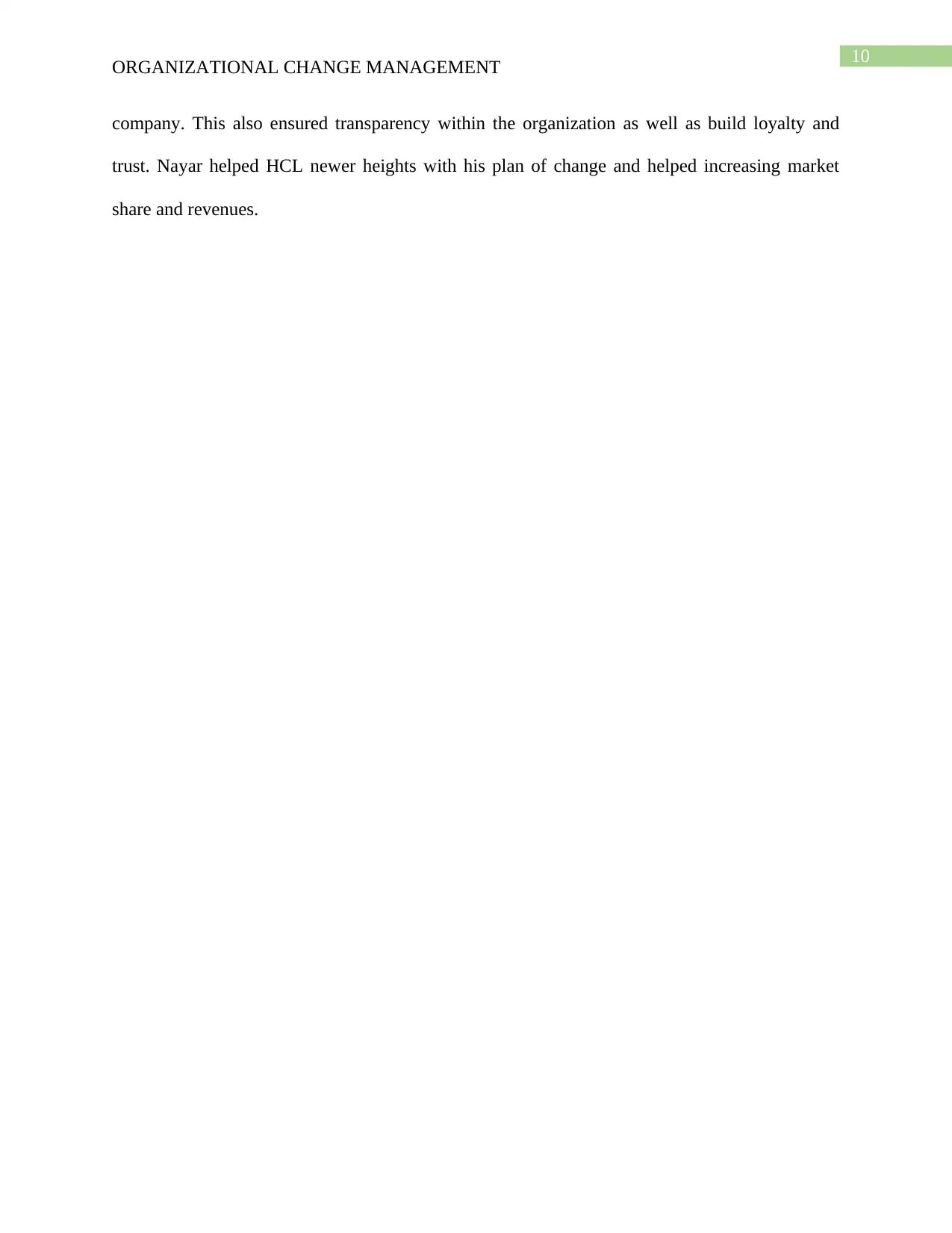
10
ORGANIZATIONAL CHANGE MANAGEMENT
company. This also ensured transparency within the organization as well as build loyalty and
trust. Nayar helped HCL newer heights with his plan of change and helped increasing market
share and revenues.
ORGANIZATIONAL CHANGE MANAGEMENT
company. This also ensured transparency within the organization as well as build loyalty and
trust. Nayar helped HCL newer heights with his plan of change and helped increasing market
share and revenues.
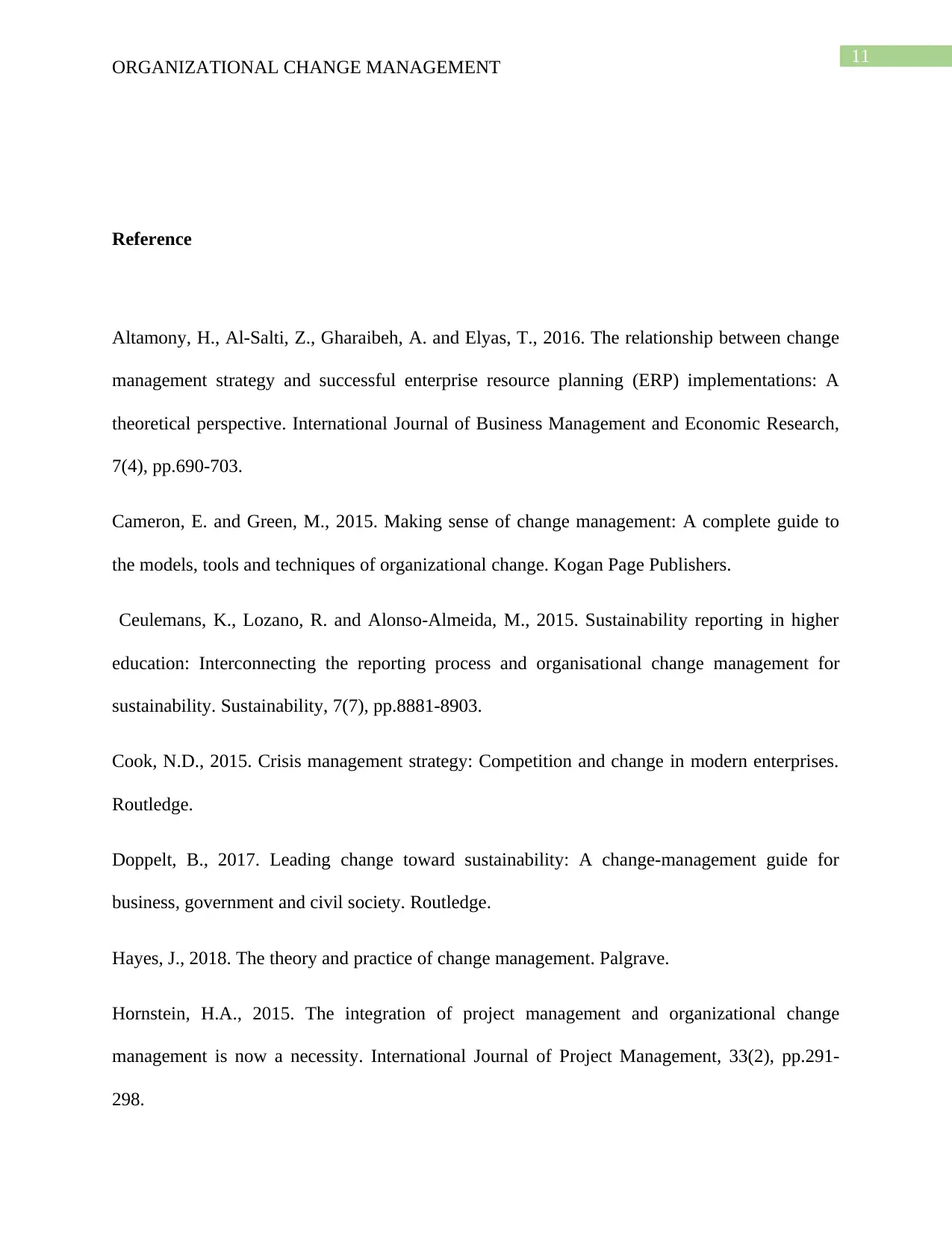
11
ORGANIZATIONAL CHANGE MANAGEMENT
Reference
Altamony, H., Al-Salti, Z., Gharaibeh, A. and Elyas, T., 2016. The relationship between change
management strategy and successful enterprise resource planning (ERP) implementations: A
theoretical perspective. International Journal of Business Management and Economic Research,
7(4), pp.690-703.
Cameron, E. and Green, M., 2015. Making sense of change management: A complete guide to
the models, tools and techniques of organizational change. Kogan Page Publishers.
Ceulemans, K., Lozano, R. and Alonso-Almeida, M., 2015. Sustainability reporting in higher
education: Interconnecting the reporting process and organisational change management for
sustainability. Sustainability, 7(7), pp.8881-8903.
Cook, N.D., 2015. Crisis management strategy: Competition and change in modern enterprises.
Routledge.
Doppelt, B., 2017. Leading change toward sustainability: A change-management guide for
business, government and civil society. Routledge.
Hayes, J., 2018. The theory and practice of change management. Palgrave.
Hornstein, H.A., 2015. The integration of project management and organizational change
management is now a necessity. International Journal of Project Management, 33(2), pp.291-
298.
ORGANIZATIONAL CHANGE MANAGEMENT
Reference
Altamony, H., Al-Salti, Z., Gharaibeh, A. and Elyas, T., 2016. The relationship between change
management strategy and successful enterprise resource planning (ERP) implementations: A
theoretical perspective. International Journal of Business Management and Economic Research,
7(4), pp.690-703.
Cameron, E. and Green, M., 2015. Making sense of change management: A complete guide to
the models, tools and techniques of organizational change. Kogan Page Publishers.
Ceulemans, K., Lozano, R. and Alonso-Almeida, M., 2015. Sustainability reporting in higher
education: Interconnecting the reporting process and organisational change management for
sustainability. Sustainability, 7(7), pp.8881-8903.
Cook, N.D., 2015. Crisis management strategy: Competition and change in modern enterprises.
Routledge.
Doppelt, B., 2017. Leading change toward sustainability: A change-management guide for
business, government and civil society. Routledge.
Hayes, J., 2018. The theory and practice of change management. Palgrave.
Hornstein, H.A., 2015. The integration of project management and organizational change
management is now a necessity. International Journal of Project Management, 33(2), pp.291-
298.
⊘ This is a preview!⊘
Do you want full access?
Subscribe today to unlock all pages.

Trusted by 1+ million students worldwide
1 out of 13
Related Documents
Your All-in-One AI-Powered Toolkit for Academic Success.
+13062052269
info@desklib.com
Available 24*7 on WhatsApp / Email
![[object Object]](/_next/static/media/star-bottom.7253800d.svg)
Unlock your academic potential
Copyright © 2020–2025 A2Z Services. All Rights Reserved. Developed and managed by ZUCOL.





